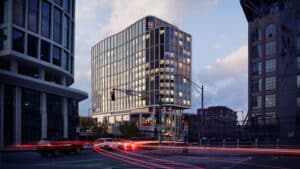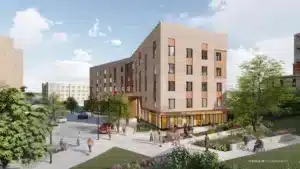
The 399-room citizenM hotel scheduled to open this summer in Back Bay is New England’s first high-rise building equipped with an all-electric HVAC system. The Samuels & Assoc. project could serve as a model for commercial developments required to meet future green building regulations in Boston. Image courtesy of Elkus Manfredi Architects and concrete Amsterdam
The next hurdle for developers that want to build in Boston will challenge them to include decarbonized materials and green building designs to reduce their fossil fuel footprints.
In this month’s State of the City address, Mayor Michelle Wu announced that her administration will propose a “zero net carbon zoning” code, four words with wide-ranging implications for how buildings are designed and operate.
The new regulations could require new construction techniques, such as use of low-carbon building materials, and mandate the use of on-site renewable energy sources such as solar arrays.
Gail Sullivan, managing principal of Studio G architects in Jamaica Plain, said such changes could mean higher initial project costs but longer-term savings for developers.
“You might be paying more upfront, but you pay less on the operating side,” Sullivan said. “Maybe it takes you seven or 10 years, but you recoup it. In this existential crisis that we are in, having the requirements in place makes my work much easier. I’m not having to convince clients one-by-one of what we ought to do.”
After Setback, Boston Takes Different Path
In November, Wu withdrew Boston’s bid to become part of a state pilot program that would ban fossil fuel hookups such as natural gas systems in new buildings. State regulators had indicated Boston would be unlikely to be approved because the pilot sought a diverse set of communities for the test ban, and the city shares many characteristics with other pilot program communities such as Cambridge.
Now Boston appears ready to impose some of the same requirements through amendments to its zoning code.
The Boston Planning & Development Agency presented potential models for the “zero net carbon zoning building initiative” at a series of meetings in 2022. The new regulations were divided into two broad categories: one seeking to decarbonize building design and construction techniques, the other reducing fossil fuel use during operations.
On the construction side, the regulations would seek to limit the use of building materials that require intensive fossil fuel use in their production, such as steel and concrete.
On the operational side, the new zoning code could require on-site renewable energy such as solar arrays or geothermal systems, or the purchase of renewable energy credits as an alternative. Solar and geothermal systems can be difficult in urban environments, because of small building lots and shadows from neighboring buildings.
The new regulations would have the biggest effect upon new construction projects, which are feeling pressures on profitability from inflation and higher interest rates. The 2022 draft proposal would impose the new requirements on all projects 20,000 square feet and larger. The 2022 proposal also included a minimum LEED Gold certification for all projects, as defined by the U.S. Green Building Council.
As opposed to the zoning changes, which apply to new construction, Boston’s recently-approved Building Emissions Reduction and Disclosure Ordinance (BERDO) has a broader reach on existing buildings 35,000 square feet and larger starting in 2025.
BPDA officials were not available for comment on specifics of the upcoming zero carbon proposal, but a spokeswoman said it will incorporate elements of the state’s new stretch energy code and the city’s BERDO rules.

The Kenzi, a 50-unit affordable senior housing project under construction in Roxbury’s Nubian Square, includes rooftop solar arrays and all-electric building systems that demonstrate the use of green building practices in a dense urban environment. Image courtesy of DREAM Collaborative
Proving the Business Case for Mainstream Builders
Until recently, the most aggressive sustainable building projects in Boston have been pursued by deep-pocketed institutions such as universities that have virtually unlimited real estate investment timelines.
Boston University completed Boston’s largest building without fossil fuel systems in 2022. A network of 31 geothermal wells drilled to a depth 1,500 feet under a neighboring property are used to heat and cool its 345,000-square-foot Center for Competing & Data Science building at 665 Commonwealth Ave.
But a handful of private and nonprofit developers are nearing completion of projects that could be proving grounds for wider adoption of elevated green building standards.
A 13-story citizenM hotel being developed by Boston-based Samuels & Assoc. at 408 Newbury St. will become the first high-rise construction in New England using all-electric HVAC systems. Designed by Elkus Manfredi Architects and architects Concrete Amsterdam, the 399-room hotel includes a high-performance building envelope that helps reduce energy costs by 25 percent, according to the design team.
In Roxbury’s Nubian Square, a project by Boston-based nonprofit Preservation of Affordable Housing will include rooftop solar arrays, energy recovery units that recycle interior air and a battery storage unit that supplies emergency power.
POAH’s Kenzi at Bartlett Station will include 50 income-restricted senior housing units.
Charlie Dirak, a senior project manager for POAH, said the additional costs associated with the building’s Passive House design have declined as contractors and engineers in Massachusetts have become more experienced with the tight building envelope construction technique.
“The cost premium has come down quite a bit, probably less than 5 percent,” Dirak said. “A couple of years ago, it was something that spooked developers from going the Passive House route. As it’s become more common, it is not that much more expensive.”
Also in Roxbury’s Nubian Square, Studio G designed the future home of Franklin Cummings Tech with all-electric building systems, despite the technical school’s demand for high energy use in facilities such as automotive and HVAC laboratories.

Steve Adams
The college’s decision reflected its increasing focus on preparing students for jobs in the green economy.
“Having our new building be LEED Gold-certified and compliant with BERDO is not only important to us as an institution, but also makes the building itself a hands-on training experience for our students,” Franklin Cummings Tech CEO Aisha Francis said in a statement.
‘Tough Tech’ Accelerator Seeks Breakthroughs
Potential new green building regulations in Boston and other communities represent a growth opportunity for Massachusetts’ expanding clean energy industry. Incubators such as Somerville’s Greentown Labs and The Engine Accelerator in Cambridge host hundreds of startups that are researching new building technologies and decarbonized energy sources.
The Engine Accelerator, which was spun out of Massachusetts Institute of Technology in 2016, occupies 188,000 square feet at a pair of locations in Cambridge currently occupied by 97 companies. Its venture capital arm has invested in approximately 50 startups that are developing technologies in the “tough tech” advanced manufacturing sector.
Ben Downing, a former Massachusetts state senator and currently the Engine’s vice president of public affairs, said the research taking place at the facility anticipates the changes in building and construction as new regulations such as Boston’s are approved.
“We see a significant market for all of these industrial decarbonization technologies driven by commercial real estate policy and the regulatory environment,” Downing said.




 |
| 